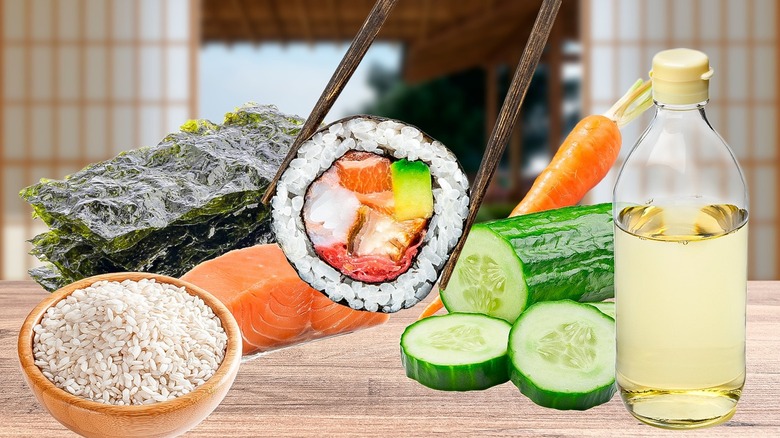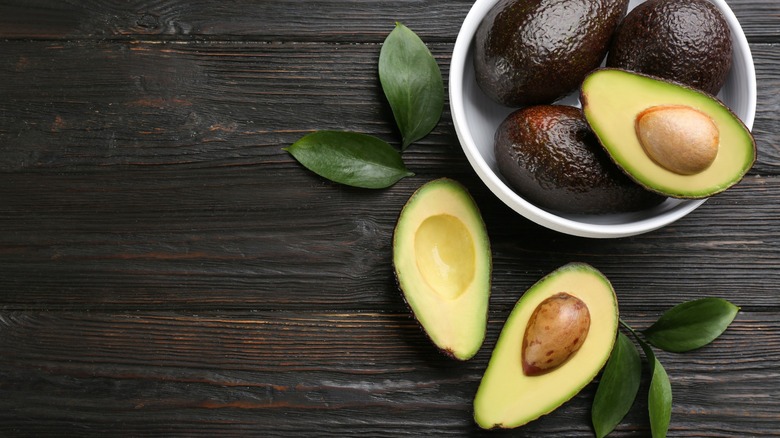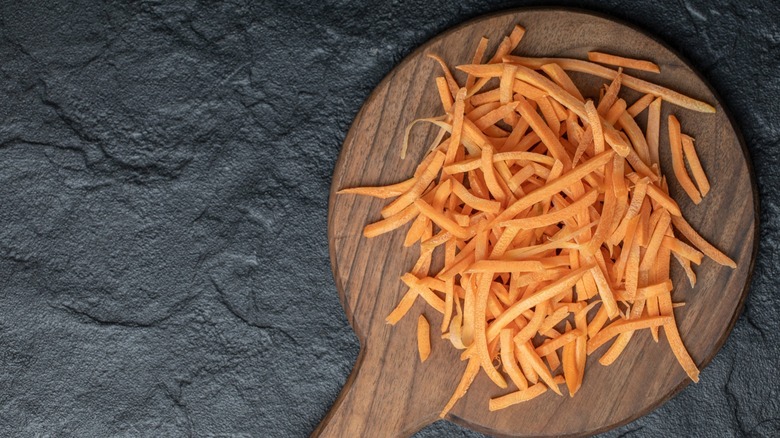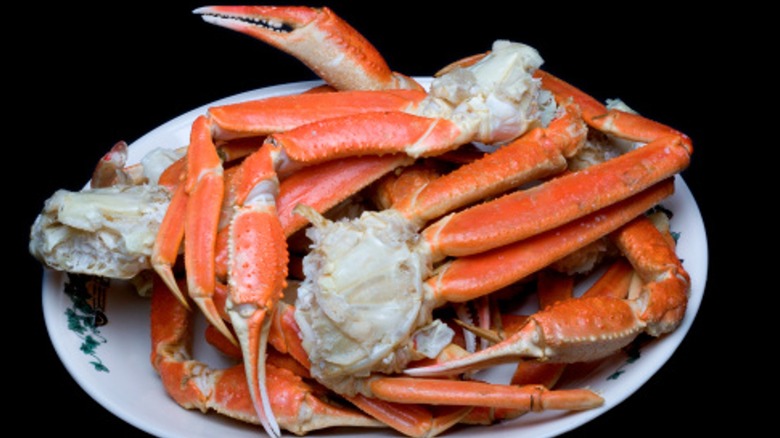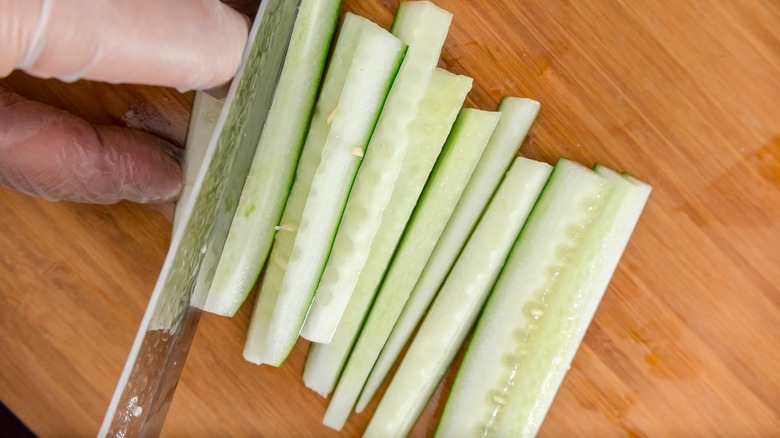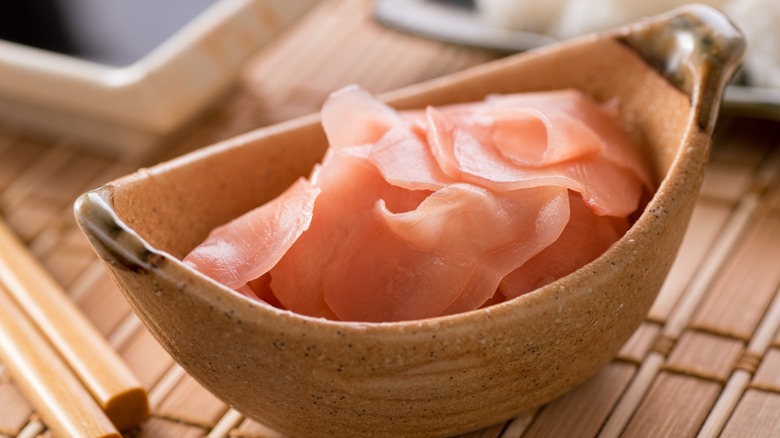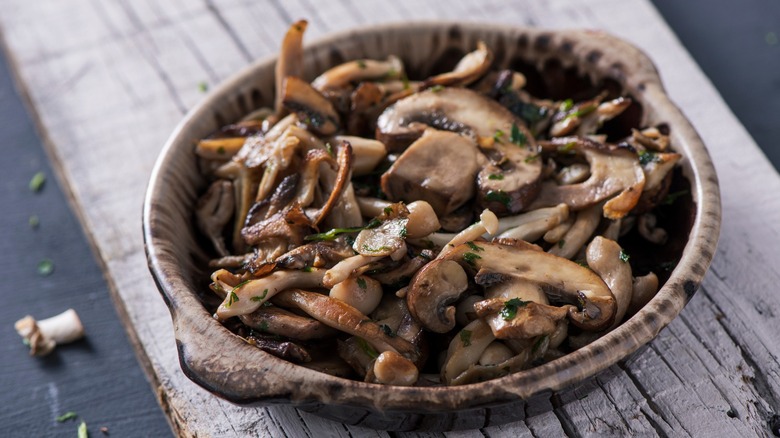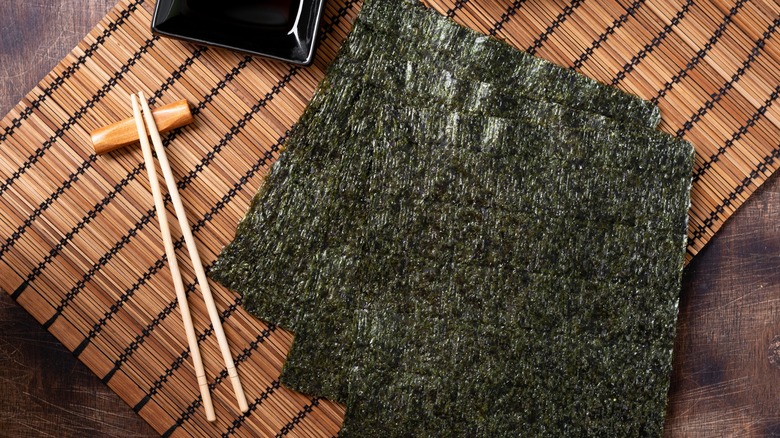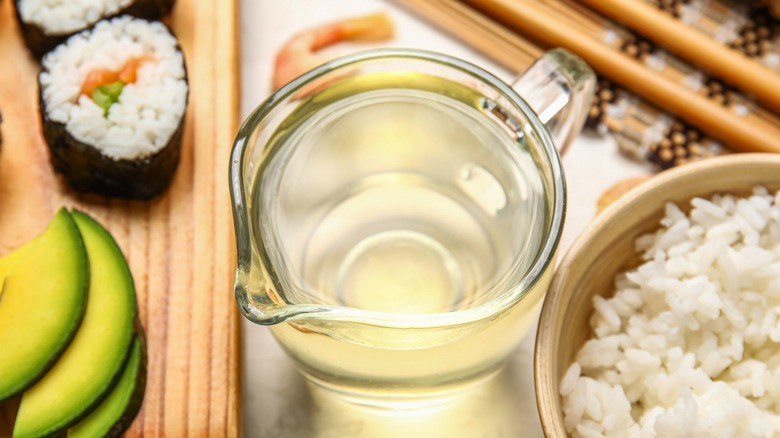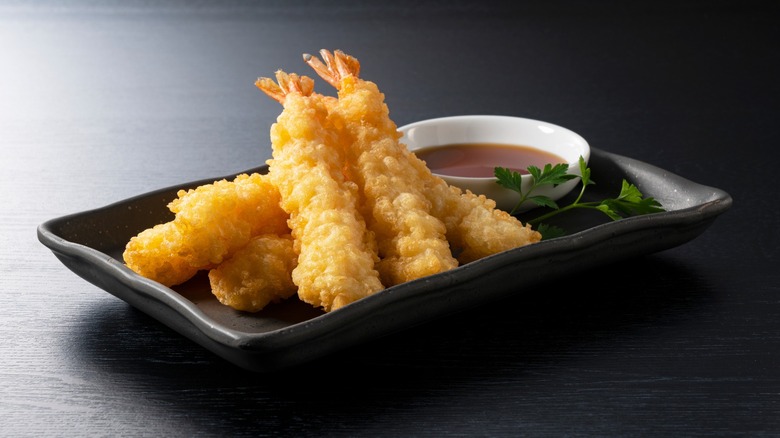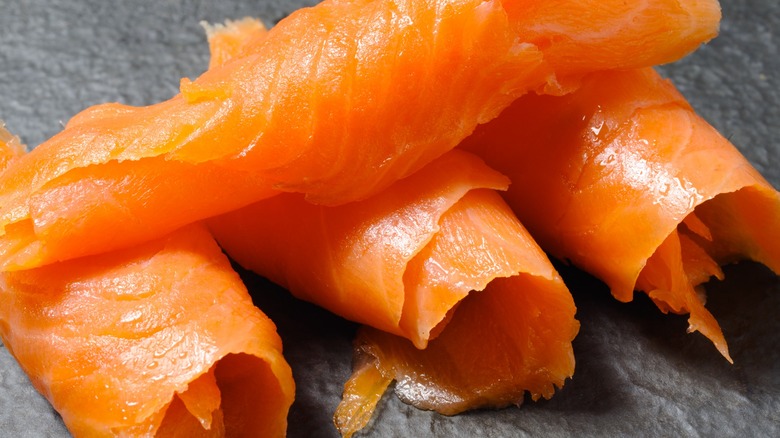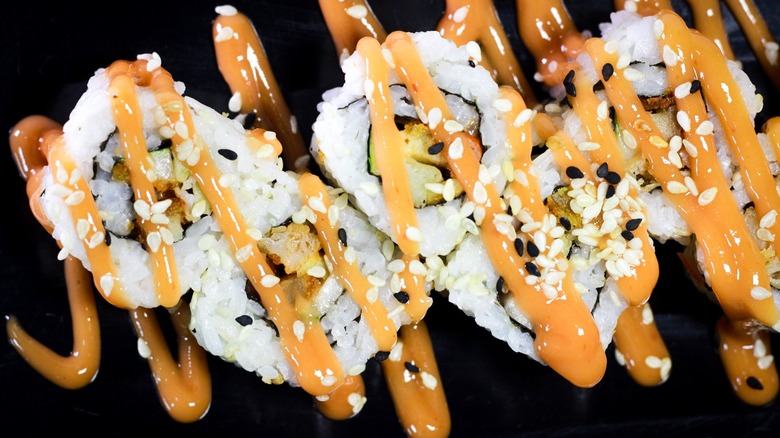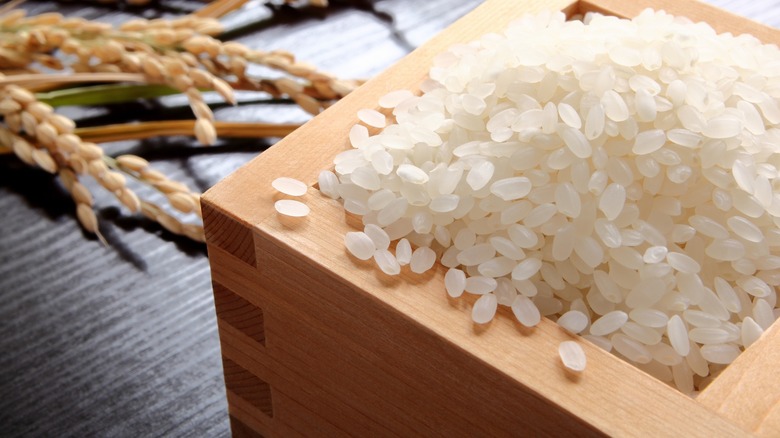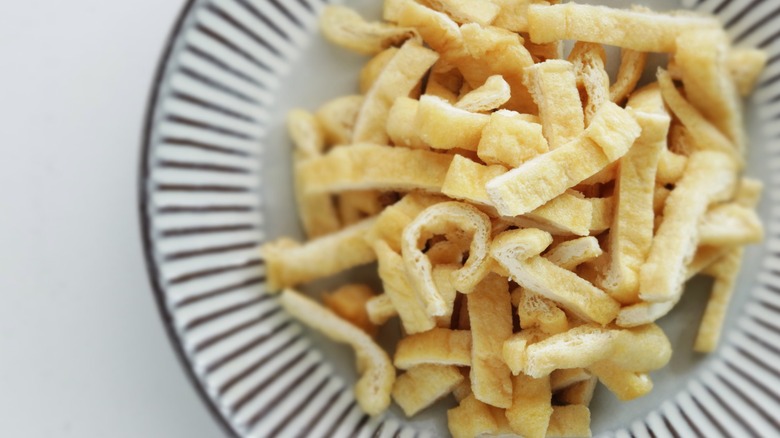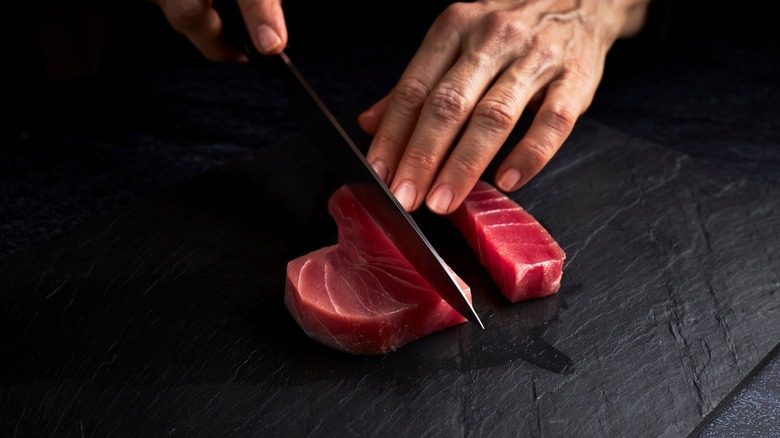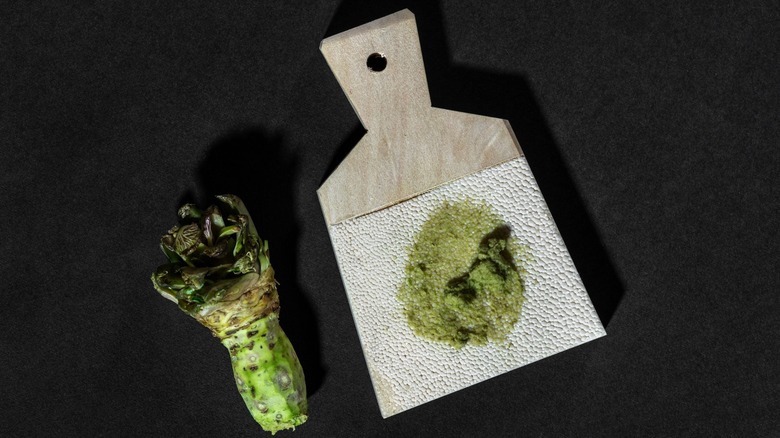17 Essential Ingredients You Need To Make Sushi At Home
Homemade sushi might just be the most satisfying way to claim dominion over your own kitchen. There might not be a more complicated or misunderstood way to show family or guests that you really know your stuff than to whip up a few perfect rolls on a whim. From tempura-coated shrimp to marinated mushrooms, you'll soon be cranking out all the most mouth-watering fillings you can imagine.
From the simplest, freshest hosomaki (sushi rolls with just one ingredient) to futomaki (fat sushi rolls stuffed with everything delicious), sushi is full of surprises. If you've been tempted to start rolling at home, let us give you a few pointers in the right direction in order to make things easier. Just remember to coat your fingers with rice vinegar before plucking a handful of warm rice (it will help to keep that stickiness at bay), mix your favorite protein and veggies, and don't look back.
Avocado
When you think avocado sushi rolls, the first thing that comes to mind are likely California rolls — and for good reason. California rolls, made with avocado, crab meat, and cucumber, with rice on the outside, are probably one of the most popular rolls in North America. Avocado isn't a traditional Japanese ingredient; instead, it was first used in 1970s North American restaurants as a way to make sushi more approachable. With its mild taste and creamy texture, avocado makes an excellent stand-in for fatty tuna when preparing sushi for vegetarians or people who aren't into raw fish.
If you decide to use avocado but are afraid of it turning brown, a little drizzle of rice vinegar over the sliced fruit will do wonders for keeping it fresh and bright until you serve your little bites. Rice vinegar works better in sushi because it won't really stand out, but go ahead and use a squirt of lemon juice if you prefer.
Carrot
If you've made sushi at home before, you already know that the longest part of the process is prepping all the ingredients. Chopping all the veggies takes much longer than the rolling, for certain. Especially when you consider that the Japanese have myriad cutting techniques, each used for specific foods. While you might not get as in-depth with your own sushi prep for some vegetables, at least you might want to listen to those who know.
Carrots add a nice crunchy texture and a pop of color — two important things in the balance of sushi. Cutting them into long, thin julienne strips helps to reduce their bulk while still giving you enough carrot-filling to see and taste. And don't think that you have to stick with raw root veg, either. Pickled or even just lightly steamed carrots will still have a firm bite but won't be overly crunchy.
Crab
There are a few ways to incorporate crab into your sushi, depending on taste, affordability, and availability. Fresh crab is great if you have the time to prepare it, but you might find that frozen imitation crab sticks are just as tasty and will save time when you just want a quick snack.
Crab is a great option for anyone who wants seafood but hesitates to try using raw fish at home. There are loads of options when it comes to choosing the type of crab you want to use, from fresh to frozen to tinned. Beyond ease of use, crab works well with all kinds of other ingredients, so the hardest part will be making up your mind about what kind of roll to make. Add cream cheese for a roll with a softer bite, or go with the classic combo of cucumber and avocado. Crab also works incredibly well when paired with something spicy, so give sriracha or shichimi togarashi (Japan's spicy, citrusy spice mixture) a try, maybe combined with some Japanese mayo.
Cucumber
Much like carrots, cucumbers are a lovely way to add instant freshness to your sushi rolls. The color and crunch help to bring balance while also keeping things healthy. In Japan, cucumber rolls (or kappa maki) are popular because of their simplicity and the cool taste that is perfect during the hot summers. If you want something a little more complex, you can add nearly any other filling to your cucumber roll, as their flavor works well with most other options.
When preparing your cucumber for sushi, look for Japanese or Persian cucumbers (rather than English or field) because they have fewer seeds and won't require as much work. Even so, most cucumbers will require you to get rid of the inner core once you've sliced it up in order to get rid of the softer center and any seeds. As well, be sure to leave the skin on so the spears retain their crunch and brightness.
Eggs
While eggs might not be your first choice when it comes to sushi fillings, we beg to differ. Tamagoyaki, in particular, is a slightly sweet omelet flavored with mirin, dashi, or soy sauce, depending on the recipe and your preferences. Usually served at the end of your meal, tamagoyaki-stuffed maki rolls are often called dessert sushi because of the lightly custardy, sweetened egg filling, but you'll find this omelet often makes an appearance during any meal during the day.
You might be worried that the Japanese omelet we think you should try will be tricky to pull off, but don't let the recipes fool you. Watch a few videos online and see how to proceed — slowly adding layer after layer of egg and rolling as you go until you have a multilayered, golden filling. Don't fret about using the requisite rectangular pan, either. You'll do nearly as well with any non-stick pan, as long as you're not concerned about having perfectly rectangular eggs.
Gari
When it comes to talking about sushi, this is the part of our job that we really hate. Explaining that the slices of young, pickled ginger (known as gari) aren't meant to be a topping for your sushi but rather should be used as a palate cleanser between the various styles of filling is tough. Say, after you eat a succulent piece of fatty tuna nigiri and before you tuck into something lighter. We groaned out loud the first time we heard that, too. But hear us out.
You can, and should, still pair sushi with ginger for the optimal taste experience. Think about it this way — overload your sushi with a slice of gari or a blob of wasabi or drown it in soy sauce, and you're just drowning out the taste that you've worked so hard to produce. Using gari as a palate cleanser also means you get to enjoy it on its own, unlike wasabi or soy sauce.
Mushroom
Mushrooms are a huge part of Japanese cuisine, and sushi is no exception. They are, after all, one of the original umami bombs, so you'd certainly expect them to show up wrapped in rice and seaweed, right? If you're not a mushroom-lover, you might be tempted to stick with white buttons, but we'd urge you to look further afield for some really tasty options. Japanese mushrooms, like shiitake, matsutake, or enoki, can be prepared in a number of ways to make your sushi shine.
Mushrooms aren't usually added raw to sushi. This means you can cook them, but you can also marinate or pickle them to add flavor and a different texture. We'll caution you to be careful when marinating them, however, as fungi do an excellent job of absorbing liquids, and you might end up with soggier sushi than you expected. Another way to use mushrooms, especially enoki, is to fry them in tempura batter and roll them up or simply use them as the ultimate garnish.
Nori Sheets
Nori, otherwise known as seaweed sheets, are the crispy green wrappers that hold everything together. And don't fool yourself into thinking that there's no nori in those inside-out California rolls; it's just hidden inside. If you just can't stand the flavors of the sea, you might be in the wrong place — sushi relies on these briny beauties to make your sticky rice and lush fillings into the poppable treasures that you crave. A tip for better sushi? The rough side of the nori sheets is always the side that touches the rice; it gives a little traction that makes rolling the rolls easier.
When buying nori, you can find plain or toasted versions, although it's pretty simple to roast them yourself at home. This also works if you have nori in the back of your cupboard that could use a little perking up. Lightly coat the sheet with oil (preferably sesame) and, with tongs, hold over a flame from your gas stove. Continue for about 20 seconds, just enough time to add a little crispness and flavor. Lay on a paper towel and sprinkle with salt before moving on to the next piece.
Rice Vinegar
Another of the must-haves for sushi is rice vinegar. An important ingredient for flavoring the sticky rice that makes sushi what it is, rice vinegar is pretty easy to find and even easier to use. You can buy rice vinegar (sometimes labeled sushi vinegar), either seasoned or unseasoned. You can go the pre-seasoned route with little fuss, but using unseasoned means that you're in charge of how much sugar or salt is added to the finished product. Really, it's all a matter of choice and availability.
Making authentic sushi rice is something that needs a little practice in order to end up with a finished product that's not too gummy but still sticky enough and has the right balance of tangy, sweet, and salty without being overpowering. Take your time while making our traditional sushi rice recipe, and don't forget that the flavors will be less pronounced when the rice cools.
Shrimp
For seafood lovers, shrimp is always a big hit when making sushi at home or for friends. Add a crispy, deep-fried layer, and no one will be able to resist your gorgeous rolls. If you're not into the deep-frying action (frozen shrimp tempura is pretty easy to find in stores — just pop them in the oven, and you're done), poached shrimp will also make a great filling as long as you don't make the biggest mistake of going too hot, too fast with your water.
Honestly, although tempura shrimp makes a terrific sushi filling, tempura veggies are also great. Try green beans, slices of squash, enoki mushrooms, or anything that could use a little extra deliciousness. And wait until you hear this option; you can absolutely fill your sushi rolls with the crispy, leftover bits of tempura (called tenkatsu) and drizzle spicy mayo over the rolls for a spicy, delicious little bite. This is such a common craving that you can actually buy bags of tempura scraps at Asian markets and online.
Smoked Salmon
Smoked salmon might have reached favor in North America because of the Philadelphia roll, but that doesn't mean it's any less tasty. Smoked salmon adds such a lovely taste to your sushi without being overpowering. Smoky, sweet, and just a little fishy, this option is close to raw salmon but without all the work or worry if you have questions about the safety of raw fish (don't fret, we're getting to that).
One of the best ways to use smoked salmon in sushi is with a shard of cream cheese in what's known as the aforementioned Philadelphia roll. Another combo to go with is avocado, like in this smoked salmon sushi. Fresh yet packed with flavor, it's easy enough to master quickly, so you can whip these up anytime you crave a creamy, seafood-packed treat in your bento lunch. Want a few more suggestions? Steam a few spears of asparagus or tempura-fry a handful of green beans for a little extra boost of crunch and taste.
Soy Sauce
To try explaining soy sauce (shoyu in Japan) in two short paragraphs absolutely won't do it justice. More than just a basic condiment in Asia, soy sauce started in China in the 5th century B.C. before spreading across Asia. Japan fell in love with the combination of soybeans, salt, and koji (a rice mold that produces many extraordinary umami bombs, including miso and mirin) and started putting a lot of effort into many variations. Adding wheat to soy sauce makes it significantly different from the Chinese version, as well as making it unsuitable for eaters who need gluten-free options.
Besides that, you really don't need to be adding loads of salty shoyu to your maki rolls anyway. If you do, you're likely eating sushi the wrong way. Think about the balance of flavors and give your sushi rice a decent amount of seasoning; those rolls should be perfect on a plate. If not, rethink your ingredients and try again.
Spicy Mayo
More of a condiment than a filling, spicy mayo is still an important part of the homemade sushi experience. You might already know this as an easy mixture of mayo and something spicy, with a squeeze of lime if you're fancy. And we're not being snobby, but if you can get your mitts on Japanese mayo (we're talking Kewpie, baby), it will make all the difference. Like Duke's in the South, Kewpie adds just the perfect umami touch to your sushi. Just trust us — we know our mayo.
This spicy topping can give your tuna roll a little more heat, but it's also a gorgeous way to add a colorful and totally tasty topping to an otherwise so-so roll. Think back to the paragraph extolling the virtues of tenkatsu (those crispy, leftover tempura bits) rolls, and you'll get it. This creamy and spicy concoction could save your first sushi attempts by perking up the overly sticky rice and limp nori alone.
Sushi Rice
One of the most important parts of sushi rolls is the rice, right? Obviously, you can't just pack a ton of ingredients into a slice of crispy seaweed and roll it up without the sweet and salty goodness of rice. Sticky rice, the basis of sushi, might be much different from the stuff you've been using, especially if you're a fan of long-grain rice. Short-grain rice needs to be rinsed to get rid of the excess starch; otherwise, you'll go from perfectly sticky to unwieldy.
Don't beat yourself up if your first sushi experiment isn't as great as what you've experienced in a restaurant. According to chef Masaharu Morimoto, of Iron Chef fame, rice is the one sushi ingredient that you shouldn't mess up because it's instrumental to perfect maki rolls. However, we really need to stress the importance of not overworking that rice; you want it to be delicately seasoned and light. Take care not to end up with a sweet and salty carbo-mass.
Tofu
There are lots of ways to use tofu, in sushi or otherwise. Don't assume that it should just be crowbarred into your dinner as a meat substitute, either, because in Japan, tofu isn't really seen that way at all. Rather, it's just another ingredient that can be used in a number of ways, from soft to firm, in both savory and sweet dishes.
In sushi rolls, strips of inari tofu are a perfectly acceptable substitute for meat but are often used in other 'dessert' sushi, much like the previously mentioned egg omelet, because of the sweet marinade. Inari tofu pouches are easy to use, as they come pre-marinated in soy sauce, sugar, dashi, and mirin, making them both sweet and savory. Often stuffed with rice and other tasty bits, inari tofu pouches can also be sliced into strips and added to your sushi rolls in place of meat or just to add a touch of sweet texture. Make them on your own, or buy the pre-seasoned pouches to slice and dice, to add a bit of intrigue to your sushi.
Tuna Steak
So you've finally decided that you're able to handle raw fish at home. Don't think we're judging you — sashimi isn't for the faint of heart. Starting with raw tuna is likely the best path for the at-home chef if you've done the research. Please don't assume that you can go fishing and start slicing up the first thing you snag; it's quite a bit more complicated than that. Sushi-grade fish means the difference between safe food and something much less delicious.
Here's the thing, sushi lovers. While sashimi (raw fish) or nigiri (raw fish on rice) might be the ultimate in mouthfuls, preparing raw fish yourself definitely needs some know-how before you set out on your own; this means that you need to be cautious when making sushi at home. Sushi-grade fish must be gutted and frozen as soon as it's caught to annihilate those pesky parasites — a practice that isn't regulated in North America. If you're itching to incorporate raw fish into your repertoire, make sure you trust your fishmonger. Otherwise, stick with something cooked and just as tasty.
Wasabi
Finally, the condiment you've all been waiting for. Wasabi can make you a hero or an overblown try-hard. Unfortunately, wasabi isn't meant to be slathered on every bite of rice and nori, like jam on a peanut butter cracker. If you can't taste the individual components of a piece of sushi, you've definitely used too much.
To add insult to injury, most wasabi in North America isn't even the real thing. Seriously — it's just horseradish and a little bit of food coloring. Real wasabi needs to be grated right before serving, on a handsome sharkskin grater, preferably, as it loses potency pretty fast. But don't fret; adding a lot of wasabi, fake or not, will really only cover up the taste of your hard work, so go easy on the green stuff. Think of it as your crowning achievement in a tiny, feisty dollop.
